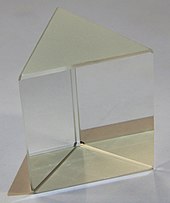Prism (optics): Difference between revisions
Citation bot (talk | contribs) m Citations: [242]+: isbn, doi. Tweaked: title. AManWithNoPlan |
→How prisms work: rmv misleading image |
||
| Line 10: | Line 10: | ||
{{Unreferenced section|date=January 2009}} |
{{Unreferenced section|date=January 2009}} |
||
[[Image:Light dispersion conceptual waves.gif|thumb|right|A triangular prism, dispersing light; waves shown to illustrate the differing wavelengths of light. (Click to view animation)]] |
|||
Light changes [[speed]] as it moves from one medium to another (for example, from air into the glass of the prism). This speed change causes the light to be [[refracted]] and to enter the new medium at a different angle ([[Huygens principle]]). The degree of bending of the light's path depends on the angle that the [[incident]] beam of light makes with the surface, and on the ratio between the [[refractive index|refractive indices]] of the two media ([[Snell's law]]). The refractive index of many materials (such as glass) varies with the [[wavelength]] or color of the light used, a phenomenon known as ''[[dispersion (optics)|dispersion]]''. This causes light of different colors to be refracted differently and to leave the prism at different angles, creating an effect similar to a [[rainbow]]. This can be used to separate a beam of white light into its constituent [[spectrum]] of colors. Prisms will generally disperse light over a much larger frequency bandwidth than [[diffraction grating]]s, making them useful for broad-spectrum [[spectroscopy]]. Furthermore, prisms do not suffer from complications arising from overlapping spectral orders, which all gratings have. |
Light changes [[speed]] as it moves from one medium to another (for example, from air into the glass of the prism). This speed change causes the light to be [[refracted]] and to enter the new medium at a different angle ([[Huygens principle]]). The degree of bending of the light's path depends on the angle that the [[incident]] beam of light makes with the surface, and on the ratio between the [[refractive index|refractive indices]] of the two media ([[Snell's law]]). The refractive index of many materials (such as glass) varies with the [[wavelength]] or color of the light used, a phenomenon known as ''[[dispersion (optics)|dispersion]]''. This causes light of different colors to be refracted differently and to leave the prism at different angles, creating an effect similar to a [[rainbow]]. This can be used to separate a beam of white light into its constituent [[spectrum]] of colors. Prisms will generally disperse light over a much larger frequency bandwidth than [[diffraction grating]]s, making them useful for broad-spectrum [[spectroscopy]]. Furthermore, prisms do not suffer from complications arising from overlapping spectral orders, which all gratings have. |
||
Revision as of 23:38, 7 February 2011


In optics, a prism is a transparent optical element with flat, polished surfaces that refract light. The exact angles between the surfaces depend on the application. The traditional geometrical shape is that of a triangular prism with a triangular base and rectangular sides, and in colloquial use "prism" usually refers to this type. Some types of optical prism are not in fact in the shape of geometric prisms. Prisms are typically made out of glass, but can be made from any material that is transparent to the wavelengths for which they are designed.
A prism can be used to break light up into its constituent spectral colors (the colors of the rainbow). Prisms can also be used to reflect light, or to split light into components with different polarizations.
How prisms work
Light changes speed as it moves from one medium to another (for example, from air into the glass of the prism). This speed change causes the light to be refracted and to enter the new medium at a different angle (Huygens principle). The degree of bending of the light's path depends on the angle that the incident beam of light makes with the surface, and on the ratio between the refractive indices of the two media (Snell's law). The refractive index of many materials (such as glass) varies with the wavelength or color of the light used, a phenomenon known as dispersion. This causes light of different colors to be refracted differently and to leave the prism at different angles, creating an effect similar to a rainbow. This can be used to separate a beam of white light into its constituent spectrum of colors. Prisms will generally disperse light over a much larger frequency bandwidth than diffraction gratings, making them useful for broad-spectrum spectroscopy. Furthermore, prisms do not suffer from complications arising from overlapping spectral orders, which all gratings have.
Prisms are sometimes used for the internal reflection at the surfaces rather than for dispersion. If light inside the prism hits one of the surfaces at a sufficiently steep angle, total internal reflection occurs and all of the light is reflected. This makes a prism a useful substitute for a mirror in some situations.
Deviation angle and dispersion

Ray angle deviation and dispersion through a prism can be determined by tracing a sample ray through the element and using Snell's law at each interface. The exact expressions for prism deviation and dispersion are complex, but for small angle of incidence and small angle they can be approximated to give a simple formula. For the prism shown at right, the indicated angles are given by
- .
For a prism in air . Defining , the deviation angle is given by
The dispersion is the wavelength-dependent deviation angle of the prism, so that for a thin prism the dispersion is given by
Prisms and the nature of light
In Isaac Newton's time, it was believed that white light was colorless, and that the prism itself produced the color. Newton's experiments convinced him that all the colors already existed in the light in a heterogeneous fashion, and that "corpuscles" (particles) of light were fanned out because particles with different colors traveled with different speeds through the prism. It was only later that Young and Fresnel combined Newton's particle theory with Huygen's wave theory to show that color is the visible manifestation of light's wavelength.
Newton arrived at his conclusion by passing the red color from one prism through a second prism and found the color unchanged. From this, he concluded that the colors must already be present in the incoming light — thus, the prism did not create colors, but merely separated colors that are already there. He also used a lens and a second prism to recompose the spectrum back into white light. This experiment has become a classic example of the methodology introduced during the scientific revolution. The results of this experiment dramatically transformed the field of metaphysics, leading to John Locke's primary vs secondary quality distinction.
Newton discussed prism dispersion in great detail in his book Opticks.[1] He also introduced the use of more than one prism to control dispersion.[2] Newton's description of his experiments on prism dispersion was qualitative, and is quite readable. A quantitative description of multiple-prism dispersion was not needed until multiple prism laser beam expanders were introduced in the 1980s.[3]
Types of prisms
Dispersive prisms
Dispersive prisms are used to break up light into its constituent spectral colors because the refractive index depends on frequency; the white light entering the prism is a mixture of different frequencies, each of which gets bent slightly differently. Blue light is slowed down more than red light and will therefore be bent more than red light.
Grisms (grating prisms)
Diffraction gratings may be replicated onto prisms to form grating prisms, called "grisms". A transmission grism is a useful component in an astronomical telescope, allowing observation of stellar spectra. A reflection grating replicated onto a prism allows light to diffract inside the prism medium, which increases the dispersion by the ratio of refractive index of that medium to that of air.
Reflective prisms
Reflective prisms are used to reflect light, for instance in binoculars and prismatic sighting compasses.
- Pentaprism
- Porro prism
- Porro–Abbe prism
- Abbe–Koenig prism
- Schmidt–Pechan prism
- Dove prism
- Dichroic prism
- Amici roof prism
Polarizing prisms
There are also polarizing prisms which can split a beam of light into components of varying polarization. These are typically made of a birefringent crystalline material.
- Nicol prism
- Wollaston prism
- Nomarski prism – a variant of the Wollaston prism with advantages in microscopy
- Rochon prism
- Sénarmont prism
- Glan–Foucault prism
- Glan–Taylor prism
- Glan–Thompson prism
Deflecting prisms
Prisms are also used to deflect a beam of light by a given angle, such as in beam steering, where one or more prisms are rotated to deflect the beam into any desired angle within a conical "field of regard". The most commonly found implementation is a Risley prism pair.[4]
In optometry
By shifting corrective lenses off axis, images seen through them can be displaced in the same way that a prism displaces images. Eye care professionals use prisms, as well as lenses off axis, to treat various orthoptics problems:
- Diplopia
- Positive and negative fusion problems[ambiguous]
- Positive relative accommodation and negative relative accommodation problems
See also
- Fresnel biprism
- Minimum deviation
- Multiple-prism dispersion theory
- Prism compressor
- Prism dioptre
- Prism (geometry)
- Theory of Colours
- Triangular prism (geometry)
- Superprism
- Eyeglass prescription
- ^ I. Newton (1704). Opticks. London: Royal Society. ISBN 0486602052.
- ^ "The Discovery of the Spectrum of Light". Retrieved 19 December 2009.
- ^ F. J. Duarte and J. A. Piper (1982). "Dispersion theory of multiple-prism beam expanders for pulsed dye lasers". Opt. Commun. 43: 303–307. doi:10.1016/0030-4018(82)90216-4.
- ^ B.D. Duncan; et al. (2003). "Wide-angle achromatic prism beam steering for infrared countermeasure applications". Opt. Eng. 42: 1038–1047. doi:10.1117/1.1556393.
{{cite journal}}: Explicit use of et al. in:|author=(help)
External links
- Geometry of Two Prism Spectroscopes
- Java applet of refraction through a prism
- Grisms (Grating Prisms)
- Fundamental Optics – CVI Melles Griot
Further Reading
- Hecht, Eugene (2001). Optics (4th ed.). Pearson Education. ISBN 0-8053-8566-5.













![{\displaystyle \delta (\lambda )\approx [n(\lambda )-1]\alpha }](https://wikimedia.org/api/rest_v1/media/math/render/svg/f8c3977ee1555ef58a7d504a3986069f805ca082)